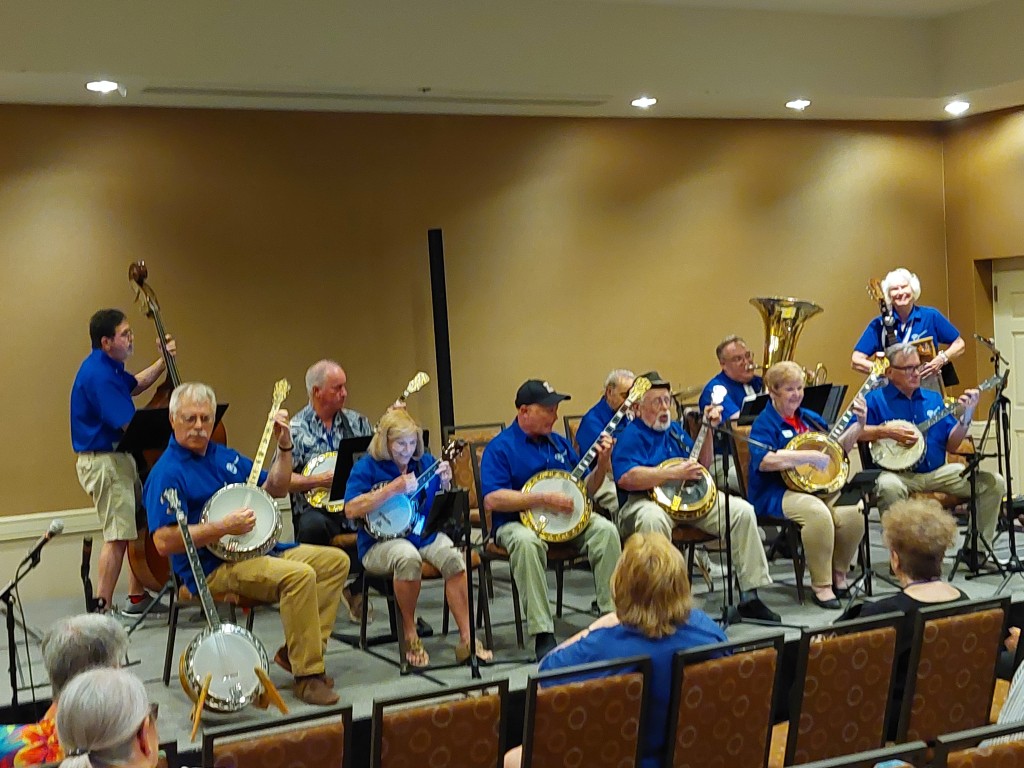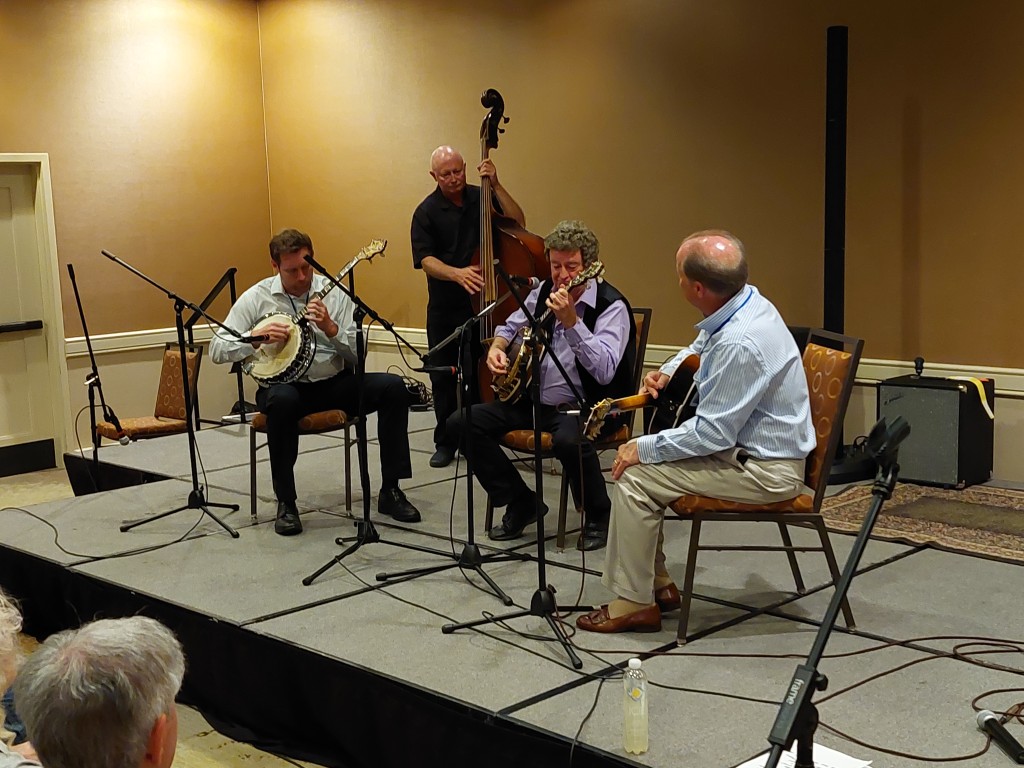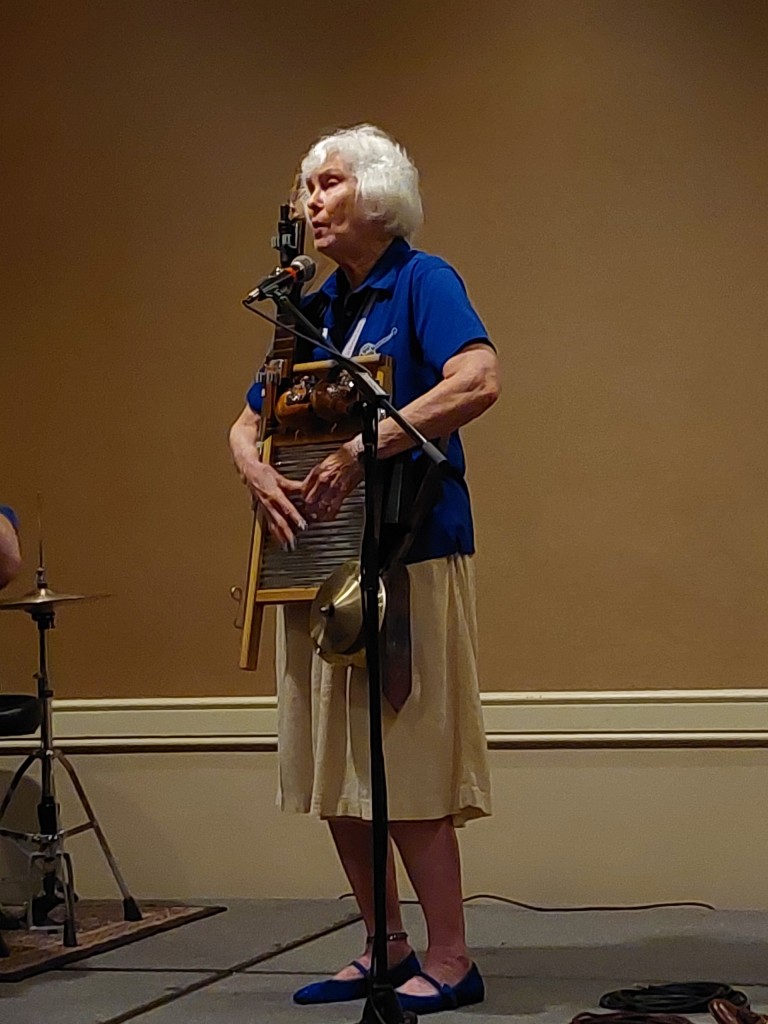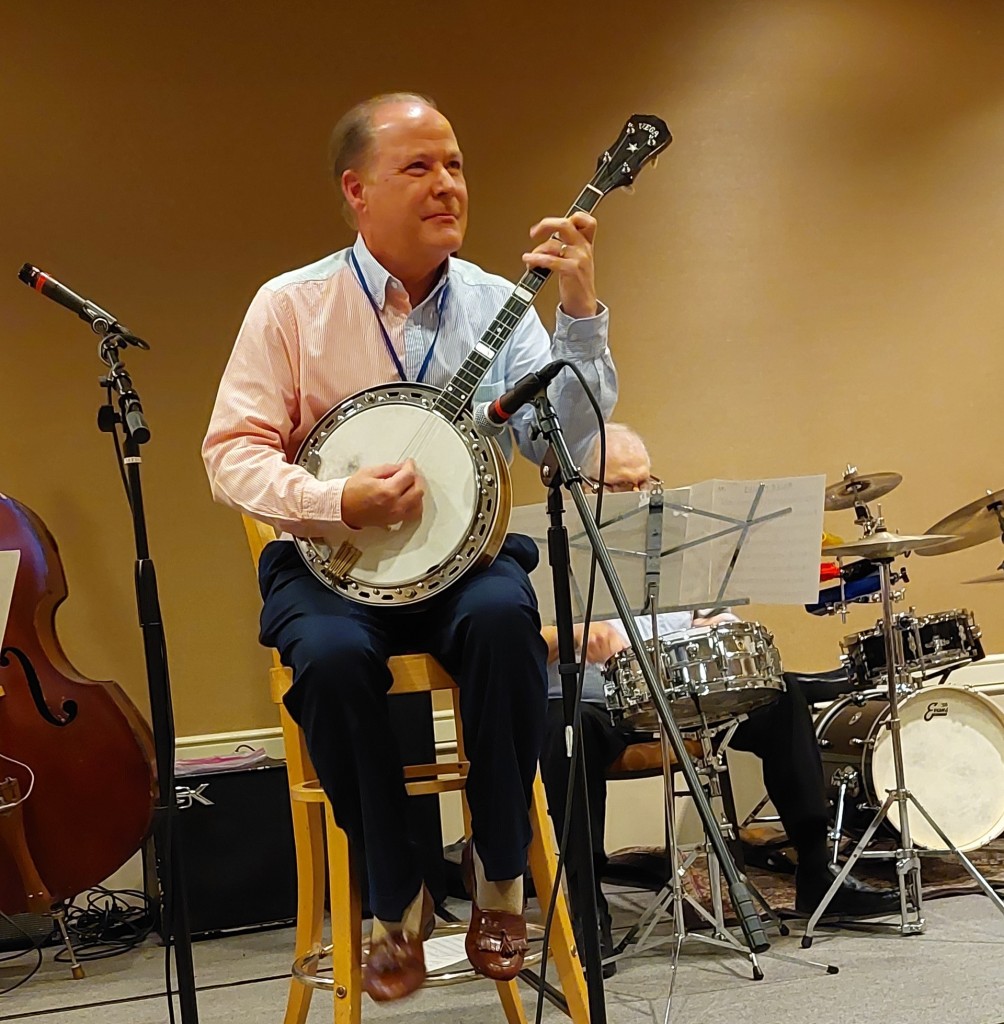Back in February, my friend Arlene Tomlinson (bs) let me know about the All Frets Reunion taking place here in Tucson in August. This annual event is more often held in the Midwest regions so this was going to be a fun diversion spearheaded by Board Member Rob Wright, leader of Arizona’s Wildcat Jazz Band. Since the venue was only two miles from my house it seemed like something I should attend, especially since I would know a few of the musicians from here and the surrounding Phoenix areas that would be performing.
The All Frets Reunion—the Fretted Instrument Guild of America (FIGA)—is celebrating its 66th year and quite a few of the attendees had been to more than 20+ of the annual gatherings. All types of guitars, banjos, mandolins, ukuleles and other kinds of fretted instruments were highlighted throughout the reunion. The sets often included a bass, tuba, keyboard, or trombone in the mix.
From the FIGA website:
Established in 1957 as the Fretted Instrument Guild of America (FIGA), ALL FRETS is an international nonprofit musical-enthusiasts organization. Our membership is made up of banjo, ukulele, mandolin, and guitar players and enthusiasts of all ages from around the world. While ALL FRETS members share a common interest in acoustic fretted instruments and the music they make, it is our spirit of community and friendship which truly makes the ALL FRETS organization unique and special. Each year our members gather at the national ALL FRETS convention to enjoy concerts, jam sessions, educational workshops and social activities. Throughout the remainder of the year, members keep in touch through both ALL FRETS magazine (a six times per year digital publication which is included with your membership) as well as the numerous regional fretted musical instrument festivals and events in which ALL FRETS members participate. For those seeking education and instruction, in addition to educational grants offered by the ALL FRETS FOUNDATION, the ALL FRETS MUSIC LIBRARY houses 1000s of individual pieces of music as well as orchestrations and educational methods.
The Saturday night meet-and-greet was open to the public so I had a few other friends with me for just the evening. We signed up as guests of Arlene for an extremely nominal charge so that we could attend some of the following afternoon workshops. Others could attend the three nightly concerts for only $10 each.
Sunday actually began the workshops, lectures and artist showcases and at first I felt a little out of place. A typical greeting was “and what do you play” would be met with my stock answer “spoons and kazoos” which raised an eyebrow or two. I thought “what the heck am I doing here” since this was a reunion of musicians, for musicians, with musicians, and by musicians. Speaking in a language of keys and chords, the handouts were definitely “over my head” in quite a few of the workshops but that feeling lasted about two minutes! It was such a delight being there in what seemed like a Private Club and I got to be an observer and revel in the banter.

Rob Wright (bj) and Sly Slipetsky (tuba) gave a talk on how the banjo is part of a band introducing rhythms and styles during solos. The banjo is a time-keeper and depending on what other rhythm instruments are involved, can play a significant role in the ensemble. Rob gave some examples of “choking” strings and Sly was smooth as silk on his rotary valve tuba.
New Mexicans Judy and Michael Muldawer concentrated on the Roaring ’20s music from Tin Pan Alley in New York City. This was at a time when published sheets of music were introduced by roaming pianists going door to door to sell the works of the lyricists and composers. Irving Berlin, who preferred the F sharp major key, lived to be 101 and wrote over 1500 songs of which more than 30 became #1 with over 280 in the top 10 of the market. He was not musically literate and had an assistant write out the score until it sounded like what was in his “ear”—a method I can certainly understand.

The first evening’s concerts began with the Dallas Banjo Band followed by Arizona’s Banjo Blasters. Other local groups included Hamilton Beech (with Arlene on bass), Wildcat Jazz Band members Rob Wright and Evan Dain with their own sets and Ron Hinkle’s set. Newly designated Banjo Hall of Famer Scott Whitfield had a jam session. Doug Parsons emceed the evening and sets were only 15 to 20 minutes each so that all of the musicians could participate either with a small group or a larger band. These musicians represented 17 States plus Canada with several other Hall of Famers giving outstanding performances.
On Monday, George Gagliardi gave a workshop on the Basics of Songwriting and the class actually wrote a song! Starting with a theme, pick some words or phrases that support the theme and create a melody. To help with the “pulse” you can substitute an already-known song to get the meter right and then abandon that tune for one you will create. George has written over a thousand songs and then performed two of his creations during his set on Monday evening. They were beautiful and conveyed a lovely message extoling butterflies and children, and the visual picture of rainbows in mason jars. You should have been there!

Another workshop given by Maine resident Dr. Jeff Grosser was designed to “provoke ideas and give musical instrument players ideas upon which to develop their own arrangements.” He focused on introductions and endings particularly for the banjo although he also plays the piano, organ, accordion, violin and other fretted instruments. With a plectrum banjo spanning 3-1/2 octaves, the chords are the same as a keyboard. Various intros include the infamous “Twelfth Street Rag” and “Oriental” styles while he listed over 20 endings including the “Shave and a Haircut” bluegrass type ending or a “Count Basie” ending or even just glissandos in either direction. Eddie Peabody’s style was mentioned several times for both intros and endings.
The Monday concerts included the local Mele Ukulele group that offered some renditions of native Hawaiian songs and a thoughtful acknowledgement of the tragedy currently besetting Maui.
Internationally known Howard Alden had a scheduled set and all were looking forward to Tyler Jackson’s playing.
Local musician Matt Mooney and New Yorker Robbert Van Renesse (his first name is with two “b”s) had some special sets, too.
A unique set featured a Flashmob—a group of about 22 of the musicians was planning to “invade” the local mall down the street the following morning. A bus was ready to transport them and their instruments to La Encantada a few miles away so this evening was their rehearsal. Doug Parsons conducted the set and encouraged a sing-a-long with the audience. Now we were in my territory having been a sing-a-long junkie both in Chicago in the late ’60s and here in Tucson in the mid ’60s, ’70s and early ’80s. It was boisterous and grand!!
Johnny Baier, Executive Director of the American Banjo Museum in Oklahoma City, emceed the Monday night concert series and performed with his own set the previous evening, while also sitting in on many other sets.

Other workshops highlighted both the Tenor and Plectrum Banjo in turning a simple song into a banjo solo, or tips on conducting a banjo band. The ukulele was a focus of a several workshops and an emphasis on strumming techniques and improvisation were discussed in others. Syncopation and various approaches to a modern use of the banjo held the audience’s attention at a few of the sessions.
Rob Wright emceed the final evening’s concerts and one set featured Washtub Jerry—yes, an actual washtub with a really strong string kept time for the musicians on that set. More banjos, guitars, ukuleles and a beautiful mandolin (it always sounds like Italy to me) with a few other rhythm instruments completed the performances. Philadelphian Stephen DiBonaventura not only had a great set but won two of the instrument door prizes. He was thrilled to add to his collection although not quite sure how to tell his wife about even more instruments that will be delivered to his doorstep.
Ron Hinkle (bj) and Sly Slipetsky (p) had a set reminiscent of evenings at Your Father’s Moustache or Shakey’s Pizza Parlor and even had a Stump the Band request—which was a song I had never heard—“Roll the Patrol,” a cute number about an elderly lady and a pending incarceration. I was impressed that Sly knew the tune and the lyrics!
All in all if you are anywhere near where the reunion will be next year (as yet it is undetermined) you need to drive or take a bus, train or plane to that location for at least one of the days. You will not be disappointed and neither was I—it was like being a fly on the wall of a room filled with tremendous talent and camaraderie yet the spirit embraced all who attended. It was a privilege I shall not soon forget!
After 48-1/2 years, Shelly Gallichio is a retired Real Estate Associate Broker in Tucson, Arizona and despite growing up in Chicago, fell in love with the clarinet and the New Orleans sound at the age of three—she intends to spend the next 48-1/2 years seeking that sound! Reach her at shellygallichio44@gmail.com






















